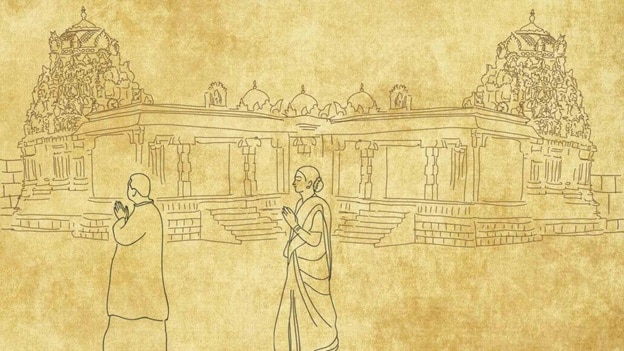
Spirituality
Pradakshina: Downloading the Positivity
An act of walking clockwise, encircling the energy source, is called circumambulation, Pradakshina, or Parikrama. Circumambulation is an integral part of Sanatana. In Sanatana, Pradakshina is performed around the temples, deities, rivers, mountains, trees, hills, animals, and cities.
In Islam, Muslims perform it by encircling Kaaba. They call it Tawaf. Buddhist circumnavigate Stupas while chanting their sacred mantras. During the holiday of Simchat Torah, Hebrews dance together, surrounding the Torah scrolls. In Catholic Church, often, a priest encircles the altar while incensing it with a thurible. They all believe that a holy place, image, object, or a living thing is a source of positive energy, and encircling it will charge them with positivity.
When did it all start?
Once, a competition took place among the Gods to travel the universe in the shortest duration. Riding their respective celestial vehicles, all the Gods departed the heavens hastily. But Lord Ganesha was in no hurry. He made his parents, Lord Shiva and Maa Parvati, sit beside each other, and after saluting Them, He circled His parents three times. As the entire universe was contained within Them, Lord Ganesha was declared the competition’s winner. Since then, Pradakshina has become an essential aspect of Puja in Sanatana.
Why is Pradakshina Performed?
Pradakshina means ‘to the right.’ Pra means to move forward, and Dakshin means south. Moving towards the south, keeping the Deity on the right side is Pradakshina. Ancient scripture of Skanda Purana decodes Pradakshina as Pra, Da Kshi, and Naa. Pra removes the heavy burden of sin; Da yields what is desired, Kshi decimates the aftereffects of bad Karma, and Na is known as the bestower of salvation.
Skanda Purana further says that when one combines all of his mind, heart, and soul while doing Pradakshina, his sins committed by the mind are destroyed in the first step itself. In the second step of Parikrama, his sins committed by his speech are dissolved. And with all his heart, when he takes the third step of Pradakshina, all the sins perpetrated by his body are decimated.
Pradakshina performed in the temple is an essential aspect of the Darshana aspect of Hinduism. It denotes that the Divine is in the centre of our existence. So, when a devotee performs Pradakshina, he tries to remember that his actions and thoughts should always encircle the Divinity. As the Pradakshina is done in a circular motion keeping God in the centre, it says that God is always fixed and will always remain at the same distance, no matter how much you travel.
It reminds the devotee that eternal truth is God, and the main focus of existence should be the Divinity itself. Like nine planets revolving around the life-given Sun, a seeker’s journey should be made while keeping God in the centre. As the Pradakshina is always performed while keeping the Divinity on the right, the devotee shall live a righteous life. By keeping a focal point on the Divine, a seeker must build a circle of his life around the Gods.
Scriptures specify the exact number of Pradakshinas to be performed for a particular Deity. Below are the minimum number of Pradakshinas to be completed for each Deity. Devotees can multiply the repetitions as well.
एका चंड्या रवे: सप्त, तिर्स्त्र: कार्या विनायके:। हरेश्चतस्त्र: कर्तव्या:, शिवस्यार्ध प्रदक्षिणा ।।
Eka Chandaya Raveh Sapta Tirstra Karya Vinayake| Hareschatarstrah Kartabyah Shivasya ardha Pradkshina||
Meaning: A devotee should perform one circumambulation for a goddess, seven for the Sun, three for Lord Ganesha, four for Lord Vishnu and his incarnations, and a half for Lord Shiva.
Lord Ganapati: One or Three times
Lord Hanuman: Three times
Lord Mahadev: Half, repeated Three times
Lord Vishnu: Three times
Lord Murugan: Six times
Divine Mother Durga: One, four, or Nine times
Peepal Tree: Seven times
Lord Surya: Two or Seven times
Yajna: Five or Eleven times
Types of Pradakshinas:
-Pradakshina of City: Ayodhya is one of the most sacred cities in Hinduism. Every year, thousands of devotees perform the Parikrama of Ayodhya, with fifty thousand Sadhus accompanying them. Vrindavan is the holy city of Uttar Pradesh. Vrindavan Parikrama is a spiritual walk encircling the city, covering Kashi Ghat, Krishna Balrama temple, Krishna Balrama tree, and many more critical spiritual sites of this holy city.
– Pradakshina of Mountains: Holy for both Hindus and Jains, the tall mountain of Girnar is located in the Gujarat state of India. Every year, a hundred thousand climb ten thousand steps as a part of Girnar Parikrama. Another sacred mountain is Mount Kailasa, which is considered the abode of Lord Shiva. Many perform Parikrama of Kailash as well. Govardhan Hill has an immense significance in the life of Lord Krishna. Devotees present offerings to the mountain Govardhan and perform rituals honouring the mountain, located in the city of Mathura. After the Puja, devotees take a walk, circling the mountain, singing and praising their beloved Kanha (Lord Krishna).
-Pradakshina of Battlegrounds: the City of Kurukshetra is the location where the legendary war of Mahabharata was fought. It’s a home to many ancient temples. Devotees come here from every corner of India to perform circumambulation of this holy place.
-Pradakshina of Rivers: Narmada river is sacred to every follower of Sanatana. Many deities perform Narmada parikrama, that is, walking the path of 2600 kilometres, encircling the river, without crossing it. Narmada parikrama is considered one of the most arduous pilgrimages globally, and thousands of devotees perform it with utmost dedication and love. -Pradakshina of the tree: Vat Purnima is a Sanatana tradition followed by married women, where they tie a thread around a giant banyan tree, encircling it seven times.
Standard rules to perform Pradakshina:
Pradakshina is a spiritual process and should be treated like it. It should be performed with complete devotion, mindfulness, and being in the present. Each step of Pradakshina is taking you closer to the Divine, and hence, it should be performed with the utmost respect.
It’s advisable that one should do this after a bath. One should not wear any footwear while performing Parikrama. This rule applies to even those devotees who travel thousands of kilometres while completing Parikrama of the sacred rivers like Narmada Maa. Devotees shall not perform Pradakshina forcefully or in a hurry. He should focus all his attention on the Deity of the temple.
It should be done in the clockwise direction. The devotee should not speak with anyone else while performing the circumambulation. Apart from Lord Shiva, every Parikrama should be done when the whole round is completed. It shall not be left in between. If possible, the seeker should chant the Guru mantra or the mantras of the Deity they are circumambulating. These are a few rules of performing Parikrama, and they may differ from Deity to Deity and from temple to temple.
Temples are not just hollow structures. These are the energy centres. When we perform Pradakshina, our body absorbs the temple’s positive energy, helping us achieve inner peace. Next time when you visit the temple, keep all the above aspects in mind. Fold your hands in Namaste Mudra, visualise your Deity in your mind, and perform the Parikrama, taking each step with mindfulness. You will feel the tide of positivity rising within you. We hope you have gained some new insight into the importance of the Gayatri Mantra.
Please subscribe to our mailing list to stay connected and receive information about spirituality. In case of any queries, please write to us at info@chamundaswamiji.com. You can check out our YouTube channel Chamunda Swamiji where you can learn Tantra, Mantra, Yantra, and Meditation from His Holiness Shri Chamunda Swamiji.
Post a Comment
-
Subscribe to Our Blog
-
Categories
-
Popular Articles
- Dead moth in the house. What universe is trying to tell you?
- Spiritual Meaning of Moth
- Vivah Bandhan Curse – What Is It and How to Spiritually Heal It.
- The Dasa Mahavidyas
- What are Beej Mantras?
- Tripura Sundari | The Dasa Mahavidya
- Maa Bhuvaneshwari | The Dasa Mahavidyas
- The Five Shades of Tantra
- Ramakrishna Paramhansa – The Man who almost became a Woman
- Bangles – A Forgotten Tradition – Their Spiritual and Health Benefits



